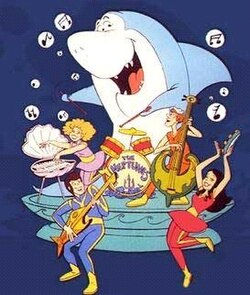
Scooby-Doo is an American media franchise owned by Warner Bros. Entertainment and created in 1969 by writers Joe Ruby and Ken Spears through their animated series, Scooby-Doo, Where Are You!, for Hanna-Barbera. The series features four teenagers: Fred Jones, Daphne Blake, Velma Dinkley, and Shaggy Rogers, and their talking Great Dane named Scooby-Doo, who solve mysteries involving supposedly supernatural creatures through a series of antics and missteps, while traveling using a brightly colored van called the "Mystery Machine". The franchise has several live-action films and shows.

Space Ghost is a fictional superhero created by Hanna-Barbera Productions in the 1960s for TV network CBS. He was designed by Alex Toth.
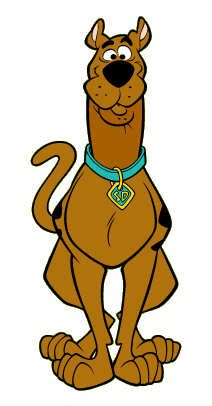
Scoobert "Scooby" Doo is the eponymous character and protagonist of the animated television franchise created in 1969 by the American animation company Hanna-Barbera. He is a male Great Dane and lifelong companion of amateur detective Shaggy Rogers, with whom he shares many personality traits. He features a mix of both canine and human behaviors, and is treated by his friends more or less as an equal. Scooby often speaks in a rhotacized way, substituting the first letters of many words with the letter 'r'. His catchphrase is "Scooby-Dooby-Doo!"

Captain Caveman and the Teen Angels is an American animated mystery comedy series created by Joe Ruby and Ken Spears and produced by Hanna-Barbera Productions for ABC. The series aired during the network's Saturday morning schedule from September 10, 1977, to June 21, 1980. All 40 episodes are available on the Boomerang subscription app.

Snagglepuss is a Hanna-Barbera cartoon character who debuted in prototype form in 1959 and established as a studio regular by 1961. A light pink anthropomorphic puma sporting an upturned collar, shirt cuffs, and bow tie, Snagglepuss enjoys the fine things in life and shows particular affinity for the theatre. His stories routinely break the fourth wall as the character addresses the audience in self-narration, soliloquy, and asides. As originally voiced by Daws Butler, Snagglepuss seeks quasi-Shakespearean turns of phrase. Some of his campy verbal mannerisms became catchphrases: "Heavens to Murgatroyd!", "Exit, stage left/right/up/down!", and a fondness for closing sentences with the emphatic "even".

Dynomutt, Dog Wonder is an American animated television series created by Joe Ruby and Ken Spears and produced by Hanna-Barbera Productions that aired on ABC from 1976 to 1977. The show centers on a Batman-esque superhero, the Blue Falcon, and his assistant, Dynomutt, a bumbling, yet effective robotic dog who can produce a seemingly infinite number of mechanical devices from his body. As with many other animated superheroes of the era, no origins for the characters are ever provided.

Pixie and Dixie and Mr. Jinks is an animated television series produced by Hanna-Barbera Productions as part of The Huckleberry Hound Show from 1958 to 1961.

Mildew Wolf is a fictional anthropomorphic wolf, main antagonist, and title character of the Cattanooga Cats segment It's the Wolf!. He is the most popular character of the series, and he was voiced by an uncredited Paul Lynde.
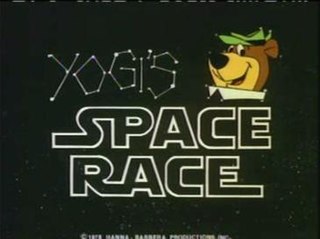
Yogi's Space Race is a 90-minute American animated television series and the third entry in the Yogi Bear franchise. Thirteen episodes were broadcast on NBC from September 9, 1978, to December 2, 1978, and featured the following four segments:

Scooby-Doo, Where Are You! is an American animated comedy television series created by Joe Ruby and Ken Spears and produced by Hanna-Barbera for CBS. The series premiered as part of the network's Saturday morning cartoon schedule on September 13, 1969, and aired for two seasons until October 31, 1970. In 1978, a selection of episodes from the later animated series Scooby's All-Star Laff-A-Lympics and The Scooby-Doo Show were aired on ABC under the Scooby-Doo, Where Are You! title name, and was released in a DVD set marketed as its third season. It also aired on BBC One in the UK from 1970 to 1973. The complete series is also available on Boomerang, Max, and Tubi streaming services.
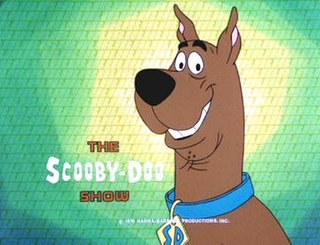
The Scooby-Doo Show is an American animated mystery comedy series. The title of the series is an umbrella term for episodes of the third incarnation of Hanna-Barbera's Scooby-Doo franchise. A total of 40 episodes ran for three seasons, from 1976 to 1978, on ABC, marking the first Scooby Doo series to appear on the channel. Sixteen episodes aired as segments of The Scooby-Doo/Dynomutt Hour in 1976, while eight aired as part of Scooby's All-Star Laff-A-Lympics in 1977. A final set of sixteen episodes came out in 1978, with ten running individually under the Scooby-Doo, Where Are You! name and the remaining six as segments of Scooby's All-Stars.

Cindy Bear is a cartoon character created by Hanna-Barbera Productions. She is one of the primary supporting characters of the Yogi Bear franchise as well as a regular in the stable of frequently appearing Hanna-Barbera animated personalities. Cindy was originally portrayed by voice actress Julie Bennett, who reprised the part for most of the character's appearances from the 1960s through the 1980s.

John Francis Smith, more commonly referred to as Ranger Smith, is a fictional park ranger first appearing in the 1958 Yogi Bear cartoon series. The character is Yogi's main antagonist, and appears in other Yogi Bear series, including Yogi's Gang (1973), Yogi's Treasure Hunt (1985), and Yo Yogi! (1991), as well as the 2010 live-action Yogi Bear film. The cartoon character has been primarily voiced by Don Messick and Greg Burson.
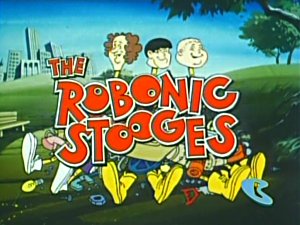
The Robonic Stooges is a Saturday morning animated series featuring the characters of The Three Stooges in new roles as clumsy crime-fighting cyborg superheroes. It was developed by Norman Maurer and produced by Hanna-Barbera Productions from September 10, 1977, to March 18, 1978, on CBS and contained two segments: The Robonic Stooges and Woofer & Wimper, Dog Detectives.

Huckleberry "Huck" Hound is a fictional cartoon character, a blue anthropomorphic coonhound dog that speaks with a North Carolina Southern drawl. He first appeared in the series The Huckleberry Hound Show. The cartoon was one of six TV shows to win an Emmy Award in 1960 as an "Outstanding Achievement in the Field of Children's Programming"; the first animated series to receive such an award.

Magilla Gorilla is a fictional gorilla and the star of The Magilla Gorilla Show by Hanna-Barbera that aired from 1963 to 1965.
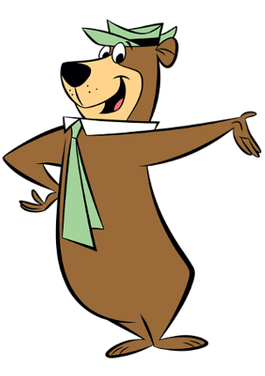
Yogi Bear is an anthropomorphic animal character who has appeared in numerous comic books, animated television shows, and films. He made his debut in 1958 as a supporting character in The Huckleberry Hound Show.

The Great Grape Ape Show is an American animated television series produced by Hanna-Barbera Productions and broadcast on ABC from September 6 to December 13, 1975. ABC continued to air it in reruns until 1978.

Laff-A-Lympics is an American animated comedy television series produced by Hanna-Barbera. The series premiered as part of the Saturday-morning cartoon program block Scooby's All-Star Laff-A-Lympics which consists of 24 episodes, on ABC in 1977. The show is a spoof of the Olympics and the ABC primetime series Battle of the Network Stars, which debuted one year earlier. It featured 45 Hanna-Barbera characters organized into teams which competed each week for gold, silver, and bronze medals. In each episode, the Really Rottens would try in each event to cheat only to get caught by Snagglepuss each time. One season of 16 episodes was produced in 1977–78, and eight new episodes combined with reruns for the 1978–79 season as Scooby's All-Stars. Unlike most cartoon series produced by Hanna-Barbera in the 1970s, Laff-A-Lympics did not contain a laugh track. Scooby’s Laff-a-Lympics was originally owned by Taft Broadcasting, Warner Bros. Domestic Television Distribution currently owns the series through its two in-name-only units, Warner Bros. Family Entertainment and Turner Entertainment.

